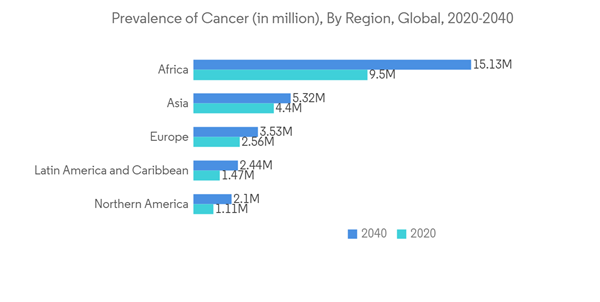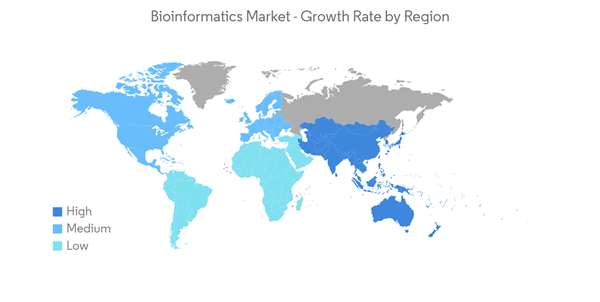The impact of COVID-19 on the market's growth was substantial in its preliminary phase. Sequencing and data analysis were termed useful tools for the characterization and detection of viruses in the environment, animals, and people during the pandemic, thereby resulting in higher usage of such computational technology across several research platforms. Information related to transmission chains was critical for public health control and containment measures, while knowledge of virus variability guided the development of vaccines and cheaper diagnostic methods. Thus, as per the analysis, the market is expected to follow the same trend over the post-pandemic phase due to emerging strains of the SARS-CoV-2 virus and an increase in research and development activities. For instance, in November 2021, Illumina donated sequencing consumables and cloud-based bioinformatics to Canadian COVID-19 projects. The donations were to support the HostSeq and VirusSeq projects of Canada's COVID-19 Genomics Network, or CanCoGen. Thus, such initiatives by the market players are anticipated to support the market's growth during the forecast period.
The growth factors for the bioinformatics market include the rising demand for nucleic acid and protein sequencing, rising initiatives from private and government organizations, the accelerating growth of proteomics and genomics, and rising research on molecular biology and drug discovery. Owing to the above factors, the global bioinformatics market is expected to experience rapid growth during the forecast period.
In July 2021, the National Institute of Technology, Rourkela (NIT-R), India, launched its Center for Bioinformatics and Computational Biology (CBCB), which will help develop novel disease biomarkers and therapeutic strategies using big data analysis. Thus, the launch of such centers using computational biology in developing countries is boosting the market growth.
Additionally, according to the data published in Mid-Year Review: New Drug Approvals in June 2021, the US FDA and Center for Drug Evaluation and Research (CDER) have authorized 26 new molecular entities (NMEs) at the halfway point of 2021 (as of June 28, 2021), which was on par with the full-year 2020 approval rate of 53 times. Except for 2018, when 59 NMEs were granted, the number of NMEs approved in 2020 was the second-highest in the last decade. The rising approvals from the FDA will further boost the research and development activities, which will in turn need databases and software to ease the process of drug design and development, in turn boosting the market's growth. Moreover, the introduction of technologically advanced bioinformatics software such as BALL, Bioclipse, RasMol, and AUTODOCK and the rising market usage of these tools for effective and accurate analysis of biomarker discovery programs that assist in toxicity detection during the initial stage of the drug development process is expected to boost the industry's growth over the upcoming years. For instance, in June 2022, My Intelligent Machines (MIMs) launched powerful software for drug development in oncology.
However, the lack of well-defined standards and common data formats for the integration of data and concerns about data complexity, as well as the shortage of user-friendly tools, are likely to hamper market growth over the forecast period.
Bioinformatics Market Trends
Sequence Analysis Platform Segment is Expected Hold a Significant Share Over the Forecast Period
In bioinformatics, sequence analysis is the process of subjecting a DNA, RNA, or peptide sequence to any of a wide range of analytical methods to understand its features, function, structure, or evolution. The advancements in next-generation sequencing (NGS) technologies regarding throughput, read length, and accuracy had a major impact on microbiome (genetic) research. These advancements have significantly improved 16S rRNA amplicon sequencing.Commercially available platforms, like Illumina MiSeq, Ion Torrent PGM, and Roche 454 GS FLX Titanium, are equipped with standard and modified library preparation protocols. These sequencing and analysis platforms can reduce sequencing errors by bioinformatically removing chimeras and other sequencing artifacts from 16S rRNA amplicon sequences generated by pyrosequencing. Such advantages of sequence analysis in the bioinformatics market are expected to propel the growth of the market segment.
Furthermore, several market players have been utilizing sequence analysis platforms for various R&D studies. For instance, in December 2021, Singular Genomics Systems Inc. announced the commercial launch of the G4, the world's most powerful benchtop sequencer. The next-generation sequencing platform featured novel high-performance chemistry and advanced engineering to deliver accuracy, flexibility, speed, and power for a range of applications, including research in oncology and immunology.
Overall, the market for the sequence analysis platform segment is expected to witness significant growth over the forecast period, primarily due to an increase in the utilization of next-generation sequencing.
North America Witnessed the Healthy Growth and is Expected To Follow the Same Trend over the Forecast Period
The North American region is leading the market due to factors such as the rise in the number of research activities pertaining to nucleic acids and genetic engineering, the increase in the budget for novel drug discovery using proteomic and metagenomic approaches, and growing awareness about biological data. The increasing innovations in molecular biology procedures, the high adoption rate of new healthcare technologies, and the high prevalence of genomic and proteomic research studies are the primary drivers for the bioinformatics market in the region.The United States contributes heavily to the research being conducted in the fields of drug discovery, genomics, and proteomics structure prediction. Various universities and research institutes have received funding from government organizations, like the National Institute of Health (NIH), and private organizations, like Gates and Melinda Foundation, for developing various bioinformatics tools and devices that can handle the bulk amount of data being generated to understand the disease prognosis and treatment options. Since the amount of genomic and proteomic data being generated is high in the United States, there are huge investments to cater to the database development and management of biological data in the country. Moreover, large-scale investments are being made in public and private research for gene therapy and drug development purposes since consumers in the United States are paying more for newer drugs. Due to consumers' shifting preferences for new drugs, research institutes are continuously engaging in novel drug discovery.
In April 2022, ATCC announced an agreement with Qiagen to provide them with sequencing data from its collection of animal and human cell lines and biological materials. Qiagen is expected to establish a database from the information to develop and deliver high-value digital biology content for the biotechnology and pharmaceutical industries, enabling the use of authenticated biological data sets to uncover new disease pathways and discover novel therapeutic targets. Such developments in the United States region are adding to the growth of the studied market.
Hence, owing to the above-mentioned factors, the market is expected to grow exponentially in the North American region.
Bioinformatics Industry Overview
The bioinformatics market is competitive with the presence of several market players. In terms of market share, a few of the major players currently dominate the market. However, with technological advancements and product innovations, mid-size to smaller companies are increasing their market presence by introducing new products. The major global players in the bioinformatics market include Illumina, Thermo Fisher Scientific, and Agilent Technologies, among others.Additional Benefits:
- The market estimate (ME) sheet in Excel format
- 3 months of analyst support
This product will be delivered within 2 business days.
Table of Contents
Companies Mentioned (Partial List)
A selection of companies mentioned in this report includes, but is not limited to:
- 3rd Millennium Inc.
- ABM
- Agilent Technologies
- BioWisdom Ltd
- Quest Diagnostics (Celera Corporation)
- Dassault Systèmes
- Data4Cure
- Geneva Bioinformatics SA
- Illumina Inc.
- Lineage Cell Therapeutics (BioTime Inc.)
- Ontoforce
- PerkinElmer
- Qiagen NV
- Rosetta Biosoftware
- Thermo Fischer Scientific (Life Technologies)










